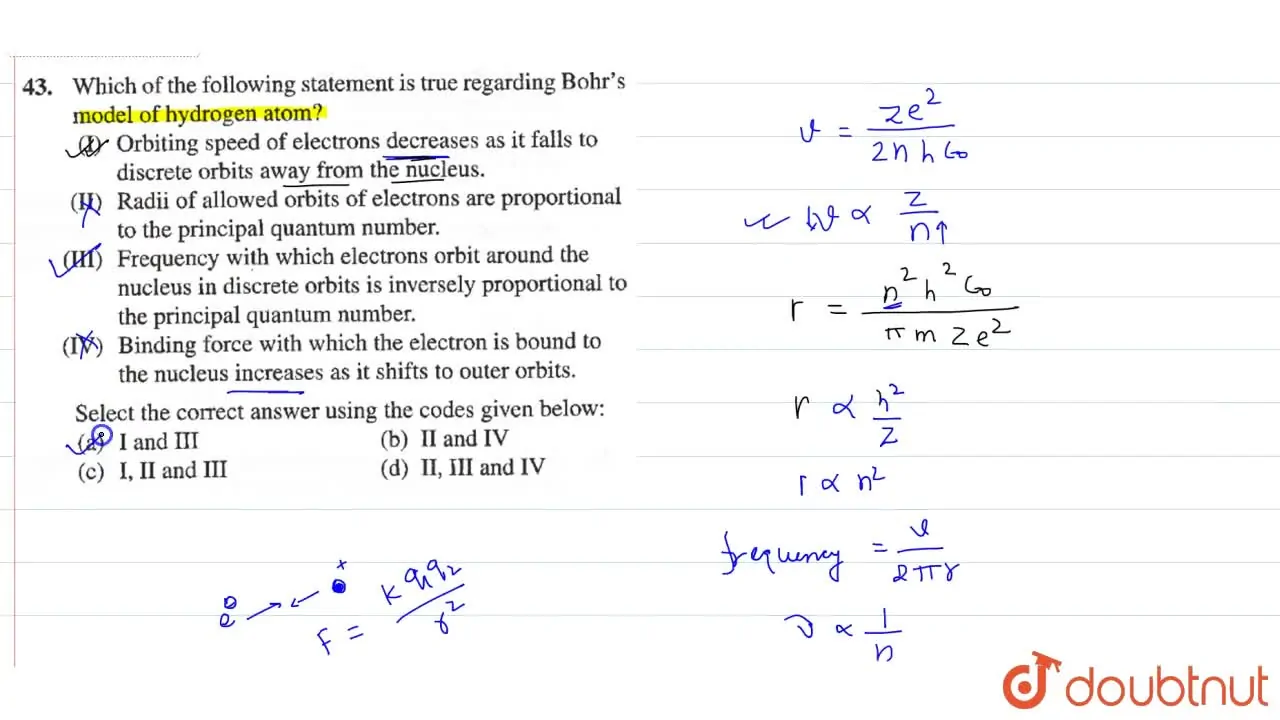Which of the following statement is true regarding Bohr's model of hydrogen atom ?
(I) Orbiting speed of electrons decreases as if falls to discrete orbits away from the nucleus.
(II) Radii of allowed orbits of electrons are proportional to the principle quantum number.
(III) Frequency with which electrons orbit around the nucleus in discrete orbits is inversely proportional to the principle quantum number.
(IV) Binding force with which the electron is bound to the nucleus increases as it shifts to outer orbits.
Selected the correct answer using the codes given below:
I and III
II and IV
I, II and III
II, III and IV
The correct Answer is:A
Speed of electron in nth orbit = 2.18×106×Zn
For hydrogen atom, Z=1
Speed of electron in nth orbit for hydrogen atom = 2.18×106n
So, as the value of n increases, orbiting speed of electron decreases.
Hence, I is correct.
Radii of an electron in nth orbit = 0.529n2ZÅ
Radii of an electron for hydrogen atom in nth orbit = 0.529n21Å
Radii is directly proportional to n2, not to n.
Hence, II is incorrect.
Time taken by an electron to complete one revolution
=1.534×10−10×n3Z2
T is proportional to n3Z2
We know, frequency with which electrons orbit in nucleus f=1T
So, f is inversely proportional to n3 for hydrogen atom
Hence, III is correct.
Binding force with which electrons is bound to nucleus = KZe2r2
In hydrogen atom, binding force = Ke2r2
And, we know, as we shift to outer orbit, r increases. So, binding force decreases.
Hence, IV is incorrect.
Related Playlists
Similar Questions
Which of the following statement is true regarding Bohr's model of hydrogen atom ?
(I) Orbiting speed of electrons decreases as if falls to discrete orbits away from the nucleus.
(II) Radii of allowed orbits of electrons are proportional to the principle quantum number.
(III) Frequency with which electrons orbit around the nucleus in discrete orbits is inversely proportional to the principle quantum number.
(IV) Binding force with which the electron is bound to the nucleus increases as it shifts to outer orbits.
Selected the correct answer using the codes given below:View SolutionWhich of the following statement is true regarding Bohr's model of hydrogen atom ?
(I) Orbiting speed of electrons decreases as if falls to discrete orbits away from the nucleus.
(II) Radii of allowed orbits of electrons are proportional to the principle quantum number.
(III) Frequency with which electrons orbit around the nucleus in discrete orbits is inversely proportional to the principle quantum number.
(IV) Binding force with which the electron is bound to the nucleus increases as it shifts to outer orbits.
Selected the correct answer using the codes given below:View SolutionAn electron orbiting around the nucleus of an atom
View SolutionThe radii of Bohr's orbit are directly proportional to
View SolutionThe linear speed of an electron in Bohr's orbit is inversely proportional to
View SolutionThe linear speed of an electron in Bohr's orbit is inversely proportional to
View Solutionthe centripetal acceleration of an electron in a Bohr's orbit is inversely proportional to
View SolutionIn the Bohr's hydrogen atom model, the radius of the stationary orbit is directly proportinal to (n= principle quantum number)
View SolutionIn Bohr's model of hydrogen atom, the total energy of the electron in nth discrete orbit is proportional to
View SolutionIn the Bohr's hydrogen atom model, the radius of the stationary orbit is directly proportional to (n = principal quantum number)
View Solution


